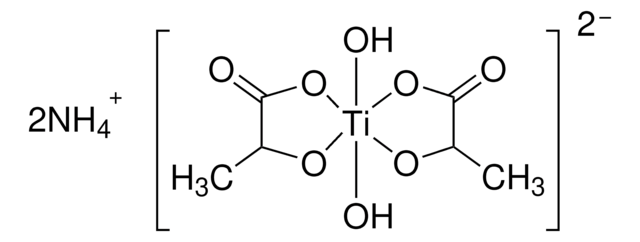325252
Titanium diisopropoxide bis(acetylacetonate)
75 wt. % in isopropanol
Sinónimos:
Diisopropoxytitanium bis(acetylacetonate) solution, TYZOR® AA organic titanate, Ti(acac)2OiPr2
About This Item
Productos recomendados
Formulario
solution
Nivel de calidad
composición
Ti, 9-10.5% gravimetric
idoneidad de la reacción
core: titanium
reagent type: catalyst
concentración
75 wt. % in isopropanol
índice de refracción
n20/D 1.4935
densidad
0.995 g/mL at 25 °C
cadena SMILES
CC(C)O[Ti](OC(C)C)(O\C(C)=C\C(C)=O)O\C(C)=C\C(C)=O
InChI
1S/2C5H8O2.2C3H7O.Ti/c2*1-4(6)3-5(2)7;2*1-3(2)4;/h2*3,6H,1-2H3;2*3H,1-2H3;/q;;2*-1;+4/p-2/b2*4-3+;;;
Clave InChI
OVSGBKZKXUMMHS-VVDZMTNVSA-L
¿Está buscando productos similares? Visita Guía de comparación de productos
Categorías relacionadas
Aplicación
Información legal
Palabra de señalización
Danger
Frases de peligro
Consejos de prudencia
Clasificaciones de peligro
Eye Dam. 1 - Flam. Liq. 2 - STOT SE 3
Órganos de actuación
Central nervous system
Código de clase de almacenamiento
3 - Flammable liquids
Clase de riesgo para el agua (WGK)
WGK 3
Punto de inflamabilidad (°F)
53.6 °F - closed cup
Punto de inflamabilidad (°C)
12 °C - closed cup
Equipo de protección personal
Eyeshields, Faceshields, Gloves, type ABEK (EN14387) respirator filter
Elija entre una de las versiones más recientes:
¿Ya tiene este producto?
Encuentre la documentación para los productos que ha comprado recientemente en la Biblioteca de documentos.
Los clientes también vieron
Artículos
New methods for materials fabrication at the micro- and nanoscale will drive scientific and technological advances in areas of materials science, chemistry, physics, and biology. The broad diversity of potentially relevant materials, length scales, and architectures underscores the need for flexible patterning approaches. One important example is the fabrication of 3D periodic structures composed of colloidal, polymeric, or semiconductor5 materials.
Titanium dioxide (TiO2) is an important n-type semiconducting material that shows interesting characteristics such as photoswitchable surface wettability, high photocatalytic activity, bistable electrical resistance states and high electron drift mobility.
Few Monolayer Atomic Layer Deposition (ALD) on Surfaces and Interfaces for Energy Applications
A Review of Mesoporous TiO2 Thin Films
Global Trade Item Number
| Número de referencia del producto (SKU) | GTIN |
|---|---|
| 325252-500ML | 4061838253231 |
| 325252-5ML | |
| 325252-100G | |
| 325252-100ML | 4061826712801 |
| 325252-500G |
Nuestro equipo de científicos tiene experiencia en todas las áreas de investigación: Ciencias de la vida, Ciencia de los materiales, Síntesis química, Cromatografía, Analítica y muchas otras.
Póngase en contacto con el Servicio técnico












